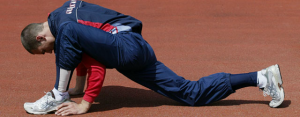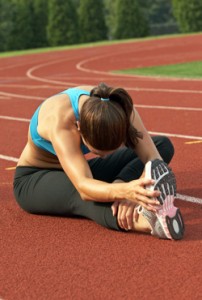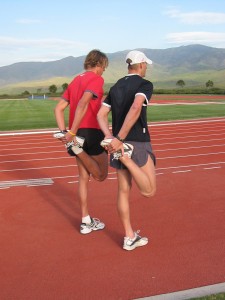Who Should Stretch & Why: The Facts About Stretching…
Are you a “Stiffie”, a “Floppie” or maybe a “Flippie”: WHO SHOULD STRETCH, WHY & THE FACTS ABOUT STRETCHING
The importance of a regular stretch program in maintaining a well-balanced, flexible body is well recognised by health professionals and exercise scientists worldwide, however, not everyone needs to stretch every muscle or even every day. So, how do you know if you need to stretch?
The concept of “Stiffies” versus “Floppies” 
This concept was developed in 1995 by physiotherapist Anna-Louise Bouvier based on each individual’s inherent level of flexibility, stability and strength (for more information, go to Physiocise website).
The essence of this concept is that flexibility varies between individuals and even between different joints in the same person. Factors such as age, weight, lifestyle, abnormal biomechanics (how our joints and muscles work) and prior injuries can all play a role in these differences.
Another big factor determining flexibility is genetics. Imagine each individual in the world can be placed on a scale based on their intrinsic, genetic tissue flexibility and mobility:
– At one end of the scale we have “stiffies”- these are people who are made-up of genetically stiffer tissues (there tissues likely have more collagen content). They have stiff joints and muscle tissue and have generally poorer flexibility. These athletes always have to work harder at maintaining flexibility and soft, healthy muscle tone.
– At the other end of the scale are “floppies’ – these people genetically have been given loose, flexible tissues (they likely have a higher content of elastin in their tissues). “Floppies” don’t have to stretch much (if at all) to maintain really good flexibility and have amazing joint flexibility (you know those ‘double-jointed’ people doing the party tricks like putting their feet behind their head). Floppies usually have soft, supple muscle tone.
– And then there are also “flippies”- these people are usually floppies but with stiff bits or stiff bits that come and go.
Put simply, Stiffies nearly always need to stretch regularly, while Floppies may not need to stretch at all, and Flippies should stretch only specific area’s that need to be stretched
Physio’s now recognise this individualised need for stretching and the potential risk of stretching for some individuals (there may be adverse effects from Floppies stretching too much or flippies stretching the wrong bits, or from stiffies stretching the wrong way), it is advised that you discuss your needs with your Physio prior to starting a stretch program (this includes yoga).
Any stretch program should also be individualised to your needs based on sport, level of participation and previous injury history.
Don’t mistake muscle “tone” with poor flexibility
Consider muscles have 2 main components:
1= flexibility. This relates to the length of the muscle or tissue
2=tone. This relates to the tension within the muscle or tissue. A muscle can have good flexibility (ie. Have enough length in it to achieve a task effectively or safely) but be too high in tone (too tense) to work effectively. Additionally, muscles that have poor tone (too soft and floopy) generally aren’t used enough and may therefore be weak.
As a rule of thumb, consider stretching to address flexibility, while massage, self-massage or self-trigger points address excessive tone. This is where regular massage for athletes, and particularly stiffie athletes is important. How regular you need to have a massage is also individual and depends on your genetic stiffies, flippie or floppie status, your frequency of muscle use and individual patterns of muscle use. Cycling as an example has extreme numbers of repetitions of movement, meaning high frequency of repeated muscle contractions in the same manner. The benefit to cycling over a weight-bearing sport like running is no ground impact forces which can often be 3-4times body weight, so muscles in cycling are not exposed to the high levels of force, just frequency of contractions.
So, What actually happens when you stretch? 
As you stretch, the soft tissue elements that surround a joint are put into a lengthened position and undergo a phenomenon known as “creep” whereby the stiffness within the tissue should begin to reduce as this lengthened state is maintained. Muscles have in-built mechanisms that act in response to stretching movements- if a tissue is stretched too quickly the muscle reacts by contracting. The more sudden the stretch, the stronger the muscle contraction will be. The muscle therefore has to be stretched slowly and held in position for a prolonged period to reduce the activation of these protective mechanisms, thereby allowing the tissues to lengthen and relax.
Types of stretching
- Static stretching is the most common technique. This is where you slowly ease into a position that places the muscle in a maximally lengthened position, with one end of the muscle fixed. This position is held for a period of time appropriate to the individual.
- Dynamic stretching involves movements of gradually increasing range of motion to meet or enhance the range of movement typically used during specific activities or sports. Examples include controlled leg and arm swings that take you (gently!) to the limits of your range of motion.
- Ballistic stretching involves trying to force a part of the body beyond its normal range of motion by the use of bouncing into or out of the stretched position. This ‘bouncing’ is considered dangerous and is not recommended. It does not allow your muscles to adjust to, and relax in, the stretched position. Consequently, the muscles’ protective mechanism (the stretch reflex) is activated and muscle tissue tensions.
- PNF (proprioceptive neuromuscular facilitation) is a technique that uses various combinations of alternating contractions and relaxations of opposing muscle groups. A partner experienced in this technique is needed to assist the individual being stretched in resisting the motions caused by muscle contraction.
The benefits of stretching
Stretching is a combination of techniques used to relax and lengthen muscles in order to increase flexibility. A stretch program that has been designed to suit your individual body and needs has a number of benefits:
– It can help to reduce muscle stiffness and muscle tension: this can improve flexibility and reduce pain that results from excess muscle tension
– improved flexibility in the right area’s results in better posture and reduced pain from poor posture
– many of our body’s tissues naturally get stiffer as we age, so regular stretching will help reduce some of the age-related tissue symptoms
– stretching may help to reduce delayed onset of muscle soreness that results from unaccustomed activity
– in relation to sports performance, most sports require a certain amount of flexibility and joint range of motion in specific area’s to allow for ideal technique. Stretching is one component that will assist in achieving this required flexibility for improved performance.
– stretching for recovery can be a relaxing experience and can help in mental recovery from sports and activity
– stretching may help reduce your injury risk. When an individualised stretch routine is combined with a strength program, some joint and muscle imbalances can be improved. Our muscles are generally organised in pairs or groups around our joints to maintain stability or to create movement. The problem arises in that certain muscles become overworked and tight whereas others become weakened, thereby creating unbalanced loads at the joints. There is no evidence to support the theory that stretching immediately before exercise prevents injury. A good warm-up, appropriately designed training programs, and correct technique is far more important in preventing injury
Should I stretch in my warm-up? 
A stretch program is not the same as a warm-up. A warm-up is a combination of sports specific exercises of increasing intensity aiming to increase the temperature of muscles and tissues thereby increasing the tissue’s ability to withstand the tress and strain of activity. A warm-up also aims to improve coordination and concentration, as well as prepare the heart and lungs for the demands of the activity. Static stretching may be one component used early in a warm-up, while dynamic stretches should be used through-out your warm-up to prepare the tissues for the requirements of activity.
Why don’t I want my muscles to be just statically stretched just before exercise?
Muscles that are in a lengthened and relaxed state are not in a condition to produce high levels of force. If you are competing in sports that require maximal strength output, such as sprinting off the start line, your muscles need to be stiff in order to produce the necessary forces. Stiffness in muscles is an important safety factor in certain sports too, such as neck muscles in football to cope with the forces of tackles and scrums. Carrying out static stretches directly before such events is therefore counterproductive, however, it is ok to perform static stretches at the start of your warm-up routine to improve mobility around a joint and then work through the rest of your warm-up to assist force generation.
Should I stretch if I am injured?
There is no straightforward answer to this question. In a lot of cases it is still possible to maintain your overall flexibility and perform a stretch program depending on the nature of the injury. In some cases of injury, specific stretching and soft tissue therapy is essential in assisting recovery from injury. A consultation with your physio is strongly recommended to assess your individual needs.
How long do I hold my stretches for?
Research trials have not come to a consensus about this. In general, I work on the principle that if you are aiming on improving flexibility then the tissues need a regular stimulus over a long period of time.
This may mean that Stiffies need to stretch everyday and it may take 4-6 weeks of stretching to achieve more permanent increases in static flexibility by 5-25%. Stretching programs must be maintained if these gains are to persist.
Floppies may only need to stretch some bits if they are feeling particularly “tight” so they may just need a very specific massage by a massage therapist that understands individual differences and doesn’t just “release” (ie aim to improve mobility in fascia tissue surrounding muscles) all muscles and soft tissues.
Any of the Physio’s at GCPSH can help you with a screening appointment to identify your body type, identify area’s of flexibility deficiencies or where you may need strengthening, and provide you with an individualized, appropriate stretch program based on your goals
